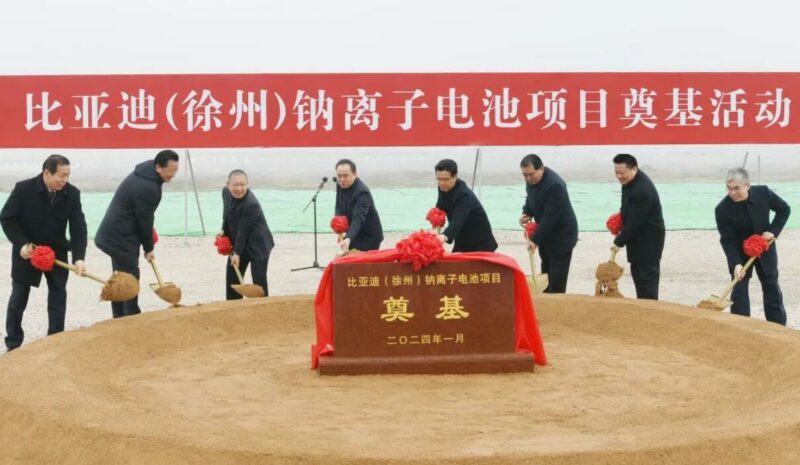BYD starts construction of 30 GWh sodium-ion battery plant in China
BYD started constructing its first sodium-ion battery plant in Xuzhou, a city about halfway between Beijing and Shanghai. The investment into the project is 10 billion yuan (USD 1.4 billion), and the planned annual output capacity is 30 GWh.
The sod-cutting ceremony was held on January 4 in Xuzhou Economic and Technological Development Zone, with representatives of all parties celebrating the first day of project construction, the local government announced today.

BYD’s subsidiary Findreams Battery signed an agreement with tricycle giant Huaihai Group to construct the Xuzhou sodium battery plant on November 18 in Shenzhen. Companies announced they would make Xuzhou the center of battery production for micro vehicles and scooters as those EVs will have the best use of sodium-ion packs.
This is not the first cooperation between BYD and Huaihai Group, as both companies teamed up to build a standard battery plant in November 2022, also in Xuzhou. This plant will produce Blade batteries with lithium iron phosphate (LFP) chemistry. Both companies jointly invested 10 billion yuan. In January last year, the construction started, and the 310,000 square meters factory is nearly ready, with trial production to begin in March 2024.
BYD Seagull was rumored to be the first mass-produced EV with a Na+ battery. However, when it was launched in April, it came with a standard LFP Blade battery from BYD. The company hasn’t commented on it since then.
Competitors
On December 27, the first mass-produced EV equipped with a sodium-ion battery rolled off the production line in China. It was a Volkswagen-backed JAC Yiwei hatchback using a sodium pack from HiNa Battery, and the deliveries will start later this month, according to HiNa.

On December 28, Ford’s joint venture partner Jiangling Motors (JMC) started mass production of another EV powered by sodium-ion battery. the car is called JMEV EV3, and the Na+ battery is supplied by Farasis Energy.


Farasis Energy says its Na+ batteries have an energy density of 140 – 160 Wh/kg, and in 2024, it will launch a new generation with a density of 160 – 180 Wh/kg. By 2026, they will produce sodium packs with 180 – 200 Wh/kg density, according to the company.
Other Chinese manufacturers are also not sleeping. CATL announced in April the first automaker to use its Na-ion batteries will be Chery Auto’s iCar brand. However, no progress since then has been announced. It has 251 km of CLTC range thanks to a 21.4 kWh sodium-ion battery and a price of 58,800 yuan (USD 8,200).
Sodium-ion advantages
“Salt” batteries are generally cheaper and do not use lithium as sodium will replace it as cathode material. It also doesn’t need other precious metals, such as cobalt or nickel, like ternary NMC batteries. However, they have a lower energy density, thus being destined for use mainly in scooters, small cars, or stationary storage.
Let’s sum up sodium-ion pros and cons:
Pros:
- Generally safer than lithium batteries
- Better performance in cold temperatures
- Slower discharge rate
- Cheaper to produce
- Better for the environment
Cons:
- Slower charge rate
- Lower attainable voltage
- Lower energy density than LFP




